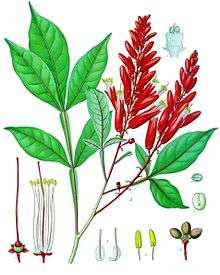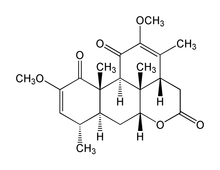Quassia amara
| Quassia amara | |
|---|---|
 | |
| Quassia amara from Koehler's Medicinal-Plants (1887) | |
| Scientific classification | |
| Kingdom: | Plantae |
| (unranked): | Angiosperms |
| (unranked): | Eudicots |
| (unranked): | Rosids |
| Order: | Sapindales |
| Family: | Simaroubaceae |
| Genus: | Quassia |
| Species: | Q. amara |
| Binomial name | |
| Quassia amara L. | |
Quassia amara (amargo, bitter-ash, bitter-wood) is a species in the genus Quassia, with some botanists treating it as the sole species in the genus. The genus was named by Carl Linnaeus who named it after the first botanist to describe it: the Surinamese freedman Graman Quassi.
Q. amara is used as insecticide, in traditional medicine and as additive in the food industry.
Morphology and Origin
It is a shrub or rarely a small tree, growing to 3 m tall (rarely 8 m). The leaves are compound and alternate, 15–25 cm long, and pinnate with 3-5 leaflets, the leaf rachis being winged. The flowers are produced in a panicle 15–25 cm long, each flower 2.5-3.5 cm long, bright red on the outside, and white inside. The fruit is a small drupe 1-1.5 cm long.
Q. amara is native to Costa Rica, Nicaragua, Panama, Brasil, Peru, Venezuela, Suriname, Colombia, Argentina, French Guiana and Guyana. Q. amara is widely planted outside its native range.
Chemical composition
In the wood a share of 0.09 to 0.17% of quassin and 0.05 to 0.11% of neoquassin was detected in Costa Rician plants.[1] Quassin is one of the most bitter substances found in nature.
Other identified components of bitterwood are: beta-carbolines, beta-sitostenone, beta-sitosterol, dehydroquassins, gallic acid, gentisic acid, hydroxyquassins, isoparain, isoparaines, isoquassins, malic acid, methylcanthins, methoxycanthins, methoxycantins, nigakilactone A, nor-neoquassin, parain, paraines, quassialactol, quassimarin, quassinol, quassol and simalikalactone D.[2]

Uses
Insecticide
Extracts of Quassia wood or bark act as a natural insecticide. For organic farming this is of particular interest. A good protection was shown against different insect pests (e.g. aphids, Colorado potato beetle, Anthonomus pomorum, Rhagoletis cerasi, Caterpillars of Tortricidae).[3] Quassin extract works as a contact insecticide. Adverse effects on beneficial organisms were not found.[4]
For Switzerland, a licensed formulation is available for organic farming.
Potential Effects on Human Health
Like any poorly studied alternative chemical applied to food crops, Quassia extract may have unknown health consequences. A study on rats in 1997 found that Quassia extract significantly reduced their fertility, reducing testes size, sperm quality and serum testosterone.[5]
Formulation
Around 200 grams (7.1 oz) of Quassia wood chips are put together with 2 litres (0.44 imp gal; 0.53 US gal) of water. It is allowed to stand for 24 hours and then it is cooked for 30 min. It is then diluted with 10 to 20 litres (2.2 to 4.4 imp gal; 2.6 to 5.3 US gal) of water and used as a spray[3] The use of approximately 3–4.5 kilograms (6.6–9.9 lb) wood extract per hectare seems to be optimal to minimize the damage of Hoplocampa testudinea on apple trees.[6]
Medicine
Traditionally, Q. amara is used as a digestive, to treat fever, and against hair parasites (lice, fleas) and Mosquito larvae in ponds (and do not harm the fishes).[2]
The component Simalikalactone D was identified as an antimalarial. The preparation of a tea out of young leaves is used traditionally in French Guyana. Experiments showed a high inhibition of Plasmodium yoelii yoelii and Plasmodium falciparum.[7]
Other uses
Extracts of Q. amara wood or bark are also used to flavor soft drinks, aperitifs and bitters which can be added to cocktails or to baked goods.[1][2]
Cultivation
Seeds and cuttings can be used for propagation of Q. amara. Frost is not tolerated, but the plant is partially drought tolerant.[8] A large amount of indirect light is recommended.[9]
References
- 1 2 Villalobos, R.; D. Marmillod; R. Ocampo (1997). "Variation in the quassin and neoquassin content in Quassia amara (Simaroubaceae) in Costa Rica: Ecological and management implications". Acta Horticulturae. 502. Retrieved 4.11.2012. Check date values in:
|access-date=(help) - 1 2 3 "Amargo". Archived from the original on 20 December 2012. Retrieved 4.11.2012. Check date values in:
|access-date=(help) - 1 2 "Quassia-Bitterholz". Ökologischer Landbau. Retrieved 3.11.2012. Check date values in:
|access-date=(help) - ↑ Eggler, B.D; Groß, A. (1996). "Quassia-Extrakte; Neue Erkenntnisse bei der Regulierung von Schadinsekten im Obstbau". Mittteilungen aus der Biologischen Bundesanstalt für Forst- und Landwirtschaft. 321: 425. Check date values in:
|access-date=(help); - ↑ Raji, Y; Bolarinwa AF (1997). "Antifertility activity of Quassia amara in male rats - in vivo study.". Life Sciences. 61: 1067–74. doi:10.1016/S0024-3205(97)00615-2. PMID 9307052.
- ↑ Psota, V.; J. Ourednickova; V. Falta (2010). "Control of Hoplocampa testudinea using the extract from Quassia amara in organic apple growing" (PDF). Horticultural Science. 37.
- ↑ S. Bertani; E. Houël; D. Stien; L. Chevolot; V. Jullian; G. Garavito; G. Bourdy E. Deharo (2006). "Simalikalactone D is responsible for the antimalarial properties of an amazonian traditional remedy made with Quassia amara L. (Simaroubaceae)". Journal of Ethnopharmacology. 106: 155–157. doi:10.1016/j.jep.2006.04.017. Retrieved 4.11.2012. Check date values in:
|access-date=(help) - ↑ "Quassia amara". tropilab. Retrieved 3.11.2012. Check date values in:
|access-date=(help) - ↑ Claire, Daniel. "Agroecological Growth Patterns of Cultivated Bitterwood (Quassia amara) on the Northwestern Caribbean Slope of Costa Rica." (PDF). Retrieved 4 November 2012.